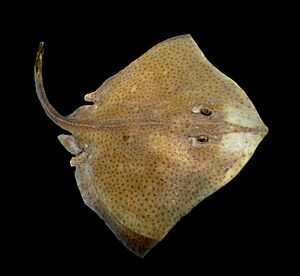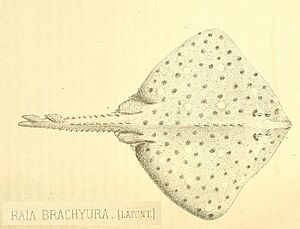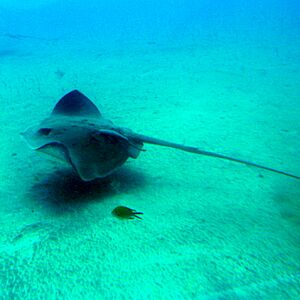Blonde ray facts for kids
Quick facts for kids Blonde ray |
|
|---|---|
 |
|
| Conservation status | |
| Scientific classification | |
| Synonyms | |
|
The blonde ray (also called the blonde skate) is a type of ray fish. It belongs to the family Rajidae. Its scientific name is Raja brachyura. This ray gets its name from its light brown color.
Contents
Where Do Blonde Rays Live?
Blonde rays live in the eastern Atlantic Ocean. They can be found deep underwater, from about 10 to 380 meters (33 to 1,247 feet) down. You might also find them sometimes in the Mediterranean Sea.
These rays are found from the western islands of Scotland all the way to Morocco. They also live in the northern and western parts of the Mediterranean Sea.
What Do Blonde Rays Look Like?
Like all rays, the blonde ray has a flat body. It has wide, wing-like pectoral fins that help it swim. Its body shape looks a bit like a kite.
Blonde rays have a short tail. This is why their scientific name is brachyura, which means "short tail" in Ancient Greek. They can grow up to 120 centimeters (about 4 feet) long.
Their color is usually light brown. They have some creamy-white spots and many dark spots. These dark spots go all the way to the edge of their body and onto their tail.
Where Do Blonde Rays Like to Live?
Blonde rays are known as bottom-dwelling fish. This means they spend most of their time on the ocean floor. They prefer areas with sand and mud.
Younger rays, called juveniles, often live in shallower waters near the coast. These areas act like nurseries for them. This means you might see more young rays closer to shore.
What Do Blonde Rays Eat?
Blonde rays are carnivores, meaning they eat other animals. Their diet includes cephalopods (like squid), small bony fish, and shrimp.
A common food for them is the common shrimp, Crangon crangon. Both young and adult blonde rays eat different types of shrimp, prawns, and other crustaceans. They are not picky eaters when it comes to these foods.
How Do Blonde Rays Grow and Reproduce?
Blonde rays are Oviparous. This means the females lay eggs. The young rays inside the eggs get all their food from a yolk sac.
Blonde rays become ready to have babies when they are about 85–92 centimeters (around 3 feet) long. This usually happens when they are about 8–10 years old.
Female rays lay their eggs between February and August. They can lay a group of eggs, called a clutch, with about 40 to 140 eggs. The average lifespan for a blonde ray is around 15 years.
How Rays Mature
Blonde rays go through different stages as they grow up. For male rays, these stages are:
- Juvenile (young)
- Adolescent (teenager)
- Adult mature (ready to reproduce)
- Adult running (actively reproducing)
Female rays have slightly different stages because they lay eggs:
- Juvenile
- Adolescent
- Adult developing (getting ready to lay eggs)
- Adult mature (ready to reproduce)
- Adult laying (actively laying eggs)
- Adult resting (resting after laying eggs)
How Humans Interact with Blonde Rays
Blonde rays are caught by people for food. They are a popular dish in the UK. In 2008, a very large blonde ray weighing 37 pounds (about 17 kg) was caught in Cobh, Ireland.
Rays, like many other skates, can be easily overfished. This is because they live a long time, grow slowly, and don't become mature until they are older. They also don't have many young. Their large size and tendency to gather in groups make them easy to catch.
Because of fishing, the growth patterns and age when rays become mature can be affected. Even though the number of rays caught has stayed somewhat steady over the last 60 years, human activities still impact the blonde ray. Since they are often found in shallower waters, it's easier for them to be caught. This means young rays can be caught before they have a chance to breed and have their own young.
Genetic Differences in Blonde Rays
Sometimes, blonde rays can have genetic differences. Two of these are leucism and Albinism.
- Leucism: This condition makes the blonde ray change from its normal brownish color with dark spots to white with black spots. Rays with leucism also tend to be smaller than usual.
- Albinism: With albinism, the ray's top side is mostly white with very few or no spots. Their eye color also changes.
Studies have shown that blonde rays with these genetic differences do not seem to have more physical damage or diseases.
See also
- Fish of the Atlantic Ocean
- Fish of the Mediterranean Sea





